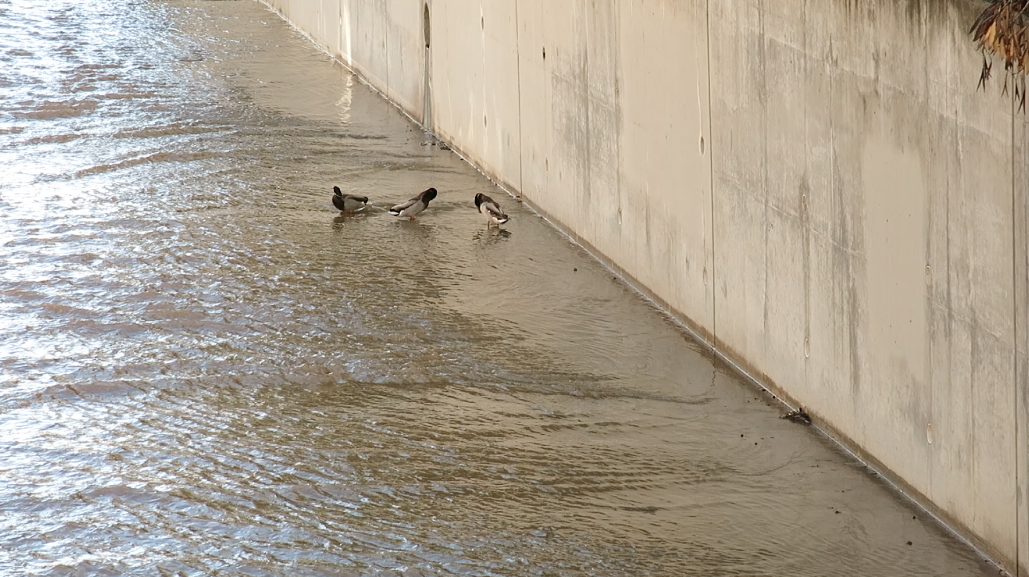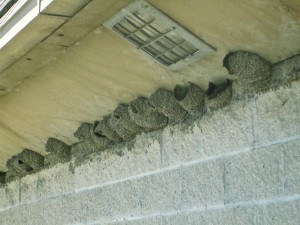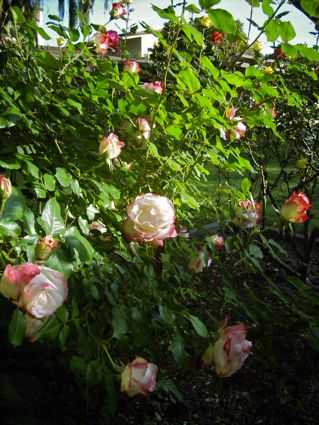The worm composter and the tire garden are right next to Adobe Creek, and some of the children look down to see how much water remains from the rain we had last week. Adobe Creek flows for about 14 miles from Black Mountain, a peak on the Monte Bello Ridge west of Palo Alto, to San Francisco Bay, draining about 10 square miles of land. (14) The creek runs in a concrete channel for its last two miles, including the stretch past the church. (15) The children stretch over the chain link fence that keeps people from falling in the ten foot deep channel to look. Water just covering the bottom of the creek flows quickly past. One of the children points at a pair of Mallards in the water.

Every time we visit the worm composter and the tire garden, we look in the creek, and we once made a special point of visiting Adobe Creek after a big rain storm so the children could video the turbid chocolate-brown waters rushing past. We are trying to make the children feel connected to our local watershed. Anabaptist theologian Ched Myers argues that too often environmentalists and eco-theologians tend to think in broad abstractions while neglecting their immediate ecological context, a tendency that can lead congregations to engage in environmental justice work that is merely “cosmetic.” Myers wants religious communities to engage in what he calls “watershed discipleship,” environmental justice centered on the bioregion of their local watershed. (16) For Myers, “watershed discipleship” should be rooted in scripture, in the Bible, though he is careful to add that the natural world is a kind of scripture; and he argues that “liturgy and spirituality” and “church practices” should also be firmly rooted in the specific bioregion of a watershed. (17) We’re teaching sixth graders in this class, most of whom are still at the concrete operational stage of cognitive development, and we’re in a post-Christian congregation. But even though Myers’s “watershed discipleship” is too abstract and too Christian to accurately describe what we’re doing, it helps explain why I and the other teachers insist on taking the children to see dirty water flowing through a concrete channel.
We walk from Adobe Creek back to our classroom, then out the back door to a covered patio to work on the half-finished nesting boxes. Before we start working, I bring up our conversation from the previous week, about House Sparrows, an invasive species, who sometimes take over nesting boxes, thus depriving native swallows of nesting habitat. Last week, I had told the children that ornithologists recommend removing and destroying House Sparrow nests in swallow nesting boxes. The children did not like the idea of destroying House Sparrow eggs, even if theses birds are a destructive invasive species. This week I admit that I probably couldn’t destroy a House Sparrow nest myself, and I ask what they think we should do. Zoe finally says she would be willing to remove a House Sparrow nest, though she wouldn’t destroy it, she would put it on the ground somewhere. “What if a cat gets the nest?” asks Toby. “Well, at least we didn’t kill it,” Zoe says.
This is our third week building nesting boxes. By now, most of the children know what to do. Catalina, who hadn’t worked on the nesting boxes before, is taken in hand by some of the other girls, who show her the plans, and some partially assembled nesting boxes. Soon Catalina is sitting on a board to hold it while Eva cuts it with the hand saw. I’m at the table where we drill pilot holes for nails. We have a system where one person holds the piece of wood, another person holds the handle of the hand drill, and a third person turns the crank handle. We keep working until the worship service ends. Frank, an older adult, happens to walk past us, and stops to see what we are doing, and soon he is working, too. The children want to keep on working , but both Lorraine and I have other commitments, so we have to end the class.

“OK, everyone stand in a circle and hold hands,” I say. “You, too, Frank.” When everyone is in a circle, and more or less holding hands, I ask everyone to say one thing that they learned, or that they’re taking away from today’s class. “Sawing is hard.” “I learned how to drill.” (Becky doesn’t say anything.) “Fun!” “Our worms are happy.” Finally we all say the unison benediction that the adults say at the end of each worship service:
Go out into the world in peace
Be of good courage
Hold fast to what is good
Return no one evil for evil
Strengthen the faint-hearted
Support the weak
Help the suffering
Rejoice in beauty
Speak love with word and deed
Honor all beings.
This is our version of a widely-used benediction derived from 1 Thessalonians 5:13-15, 21-22, (18) adapted by other Unitarian Universalists, and further adapted by our church’s senior minister when she added the phrase “Rejoice in beauty.” Most of the children in the class have memorized our version of the benediction; they mostly like saying it together; sometimes their comments make it seem that they have even thought about its meaning. I suspect that some of them would be displeased to learn that the benediction they like so well comes from the Bible.
Many of these children are from families in the middle of what political scientists Robert D. Putnam and David E. Campbell call “a gaping chasm between those who are highly religious and those who are highly secular.” (19) They fall in the middle because they’re both religious and secular at the same time. They are secular because, like the senior minister and more than half the congregation, they are atheists, they don’t pray, and/or they rarely read sacred texts—they are secular by definition, since religiosity is commonly determined in the U.S. by belief in God, the act of praying, and devotional reading of the Bible or other sacred text. (20) For further confirmation of the congregation’s “secularity,” I have learned from listening to and talking with the children and teens that most of them think of “religious” persons as intolerant; in this, their views correspond to the views Putnam and Campbell have found in highly secular Americans. (21) Yet the sixth graders in this class are “religious” if we measure religiosity, not by belief in God or prayer, but by regular attendance in a local faith community. Some of them are aware of their awkward status as both religious and secular, and sometimes they’ll say that they don’t like telling their friends they go to church because it’s hard to explain that their church doesn’t make them believe in God.
The teens in the class I teach later on Sunday morning feel this awkwardness more acutely—these teens are older, in grades 8 and 9, ranging in age from 12 to 15. They are in our “Coming of Age” class, which corresponds roughly to a confirmation class in a Protestant Christian church, or a bar/bat mitzvah class in some Jewish synagogues. In a recent Coming of Age class, I led a session on Biblical literacy, reviewing material about the Bible to which they had already been introduced in previous years in Sunday school. When I asked some pre-assessment questions, I found that the fourteen teenagers in the class could say little about the Bible; even though I know they had been exposed to this knowledge in other Sunday school classes, they are very resistant to remembering anything that smacks of “religion.” I am sympathetic to their resistance to “religion,” given how religion has been used in the West as a form of “colonial control.” (22) Given our congregation’s commitment to social justice, no wonder our children and teens resist a label that that they associate with the opposite of social justice. Yet I also I hear from teens and from their parents that they love coming to the Coming of Age class, because they get to talk about big religious questions like the nature of human beings, good and evil, etc.; they resist the label, but they love the content. All this presents a formidable pedagogical challenge: introducing children and teens to the resources of religion, without provoking further resistance.
With that in mind, let’s return to the sixth grade Ecojustice class, to see what happens after the closing circle: After the closing circle, several children volunteer, without being asked, to stay and help put away tools and materials. Several of them, almost half the class members, walk back and forth between the covered patio and my office, carrying half-finished projects, supplies, and tools. It takes fifteen minutes to get everything put away, and some of the children linger, ready to stay longer if there is something to do; but I have to get ready for the Coming of Age class, so they drift away. These sixth graders show no resistance to the religious bioregionalism of Ecojustice class; exactly the opposite: they like to know how they are connected to Violet-green Swallows and House Sparrows, to worms and compost, to Adobe Creek.
Notes:
(14) Chris D. Pilson, “Urban creek restoration, Adobe Creek, Santa Clara County, California” (Master’s thesis, San Jose State University, 2009), 10, 13.
(15) The channelization of Adobe Creek is just one of many human-induced changes. Adobe Creek may have originally terminated in a “bird’s foot distributary pattern” before it reached the bay, perhaps close to the present-day location of the church (Pilson, 58). It is probably no longer possible to reconstruct what the creek was like before Europeans arrived, and rather than focusing on the past we want children to know the creek as it is now.
(16) Ched Myers, “From ‘Creation Care’ to ‘Watershed Discipleship’: Re-Placing Ecological Theology and Practice,” The Conrad Grebel Review 32, no.3 (2014), 257, accessed March 31, 2016: link.
(17) Ibid., 266-268.
(18) Versions of this benediction, used widely in U.S. mainline congregations, may be found in the Anglican Book of Common Prayer and in the Presbyterian Book of Common Worship.
(19) Robert D. Putnam and David E. Campbell, American Grace: How Religion Divides and Unites Us (New York: Simon and Schuster, 2010), 494.
(20) Putnam and Campbell measure religiosity by asking “How frequently do you attend religious services? How frequently do you pray outside of religious services? How important is religion in your daily life? How important is your religion to your sense of who you are? Are you a strong believer in your religion? How strong is your belief in God?” (Putnam and Campbell, 18). Since half these questions involve belief and prayer, atheists who don’t pray will not be scored as highly religious. Putnam and Campbell admit there might possibly be some bias in these questions (ibid., 20).
(21) Ibid., 499-501.
(22) Robert F. Shedinger, “Jesus and Jihad: Transcending the Politics of the Sacred,” in Sacred Texts and Human Contexts: A North American Response to “A Common Word between Us and You” (Rochester, New York: Nazareth College, 2014), 120-121.






